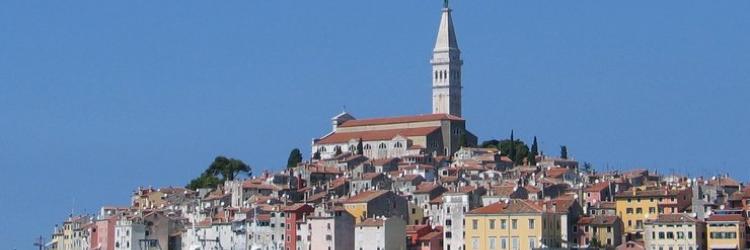Travel destinations Comments: 0 May 30, 2017
Rovinj is a coastal Istria’s city and its famous attraction. Primarily a fishing port, or to be precise, the last true Mediterranean fishing port, Today Rovinj is overrun by tourists thanks to the abilities of its citizens to benefit from their natural resources. Rovinj manages to keep up with the modern times in a very interesting way, by combining its rich tradition with the new trends.
The Old Town, contained within an egg-shaped peninsula and surrounded by luscious forests, is criss-crossed with steep cobbled streets and piazzas. The 14 islands of the Rovinj archipelago are a pleasant destionation for an afternoon away,; the most popular are Saint Catherine and Crveni Otok (Red Island). About 1.5km south is the Punta Corrente Forest Park and the wooded Golden Cape, with its age-old oak and pine trees and several large hotels.
Church of St Euphemia : Theproud ot the town, this imposing church dominates the old town from its hilltop location in the middle of the peninsula. Built in 1736, it’s the largest baroque building in Istria, reflecting the period during the 18th century when Rovinj was its most populated town. Inside,the church visitors can marvel at the marble tomb of St Euphemia behind the right-hand altar. Modelled on the belfry of St Mark’s in Venice, the 60m bell tower is topped by a copper statue of St Euphemia, which shows the direction of the wind by turning on a spindle.
Batana House is a museum dedicated to the batana, a flat-bottomed fishing boat that stands as a symbol of Rovinj’s seafaring and fishing traditions. The multimedia exhibitions inside the 17th-century town house have interactive displays, excellent captions and audio with bitinada, which are typical fishers’ songs.
The elaborate Balbi Arch was built in 1679 on the location of the former town gate. The top of the arch is ornamented with a Turkish head on the outside and a Venetian head on the inside.
Grisia: Lined with galleries where local artists sell their work, this cobbled street leads uphill from behind the Balbi Arch to St Euphemia. The winding narrow backstreets that spread around Grisia are like a maze where tourists like to lose themselves among windows, balconies, portals and squares which embody a buffling, but pleasant to the eye mixture of styles – Gothic, Renaissance, Baroque and Neoclassicism. A special attention should be paid to the unique fumaioli (exterior chimneys), built during the population boom when entire families lived in a single room with a fireplace.
Known as one of the most picturesque and romantic towns on Mediterranean, over the last few decades Rovinj attracts a large number of tourists. Most of them faithfully return year after year due to the unique combination of the breath of past times felt as you walk around old town's cobbled narrow streets, with its 22 islands and islets, the mild Mediterranean climate, carefully designed parks, the tidiness of its streets, the friendliness of the local population or numerous and varied town events.


 RS
RS  ME
ME  HR
HR  BA
BA  RU
RU  MK
MK  AL
AL  ES
ES  DE
DE  IT
IT  CN
CN  NL
NL  SE
SE  FR
FR 






Write a comment